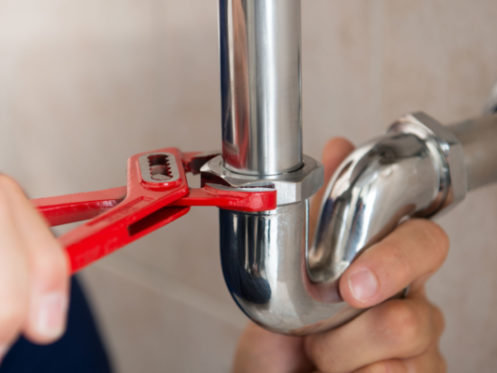Your home’s plumbing system is quite complex and has numerous different components. P-traps are one of the more important parts of the system. These are found underneath sinks and other drains and serve several vital roles. To understand exactly why they’re so important, let’s take an in-depth look at exactly what a P-trap is and how it functions.
What Is a P-Trap?
If you take a look inside the cabinet under your kitchen sink, you should see a piece of PVC pipe with a U-shaped bend at the bottom. This is the P-trap, which gets its name from the fact that it somewhat resembles the letter P flipped on its side.
The trap has threaded fittings on both ends. On one end, it connects to the pipe extending down from the drain. On the other end, it attaches to the drain pipe that eventually feeds into your main wastewater drainage system. All of your showers, bathtubs and your washing machine also have P-traps down underneath the drain.
The P-trap underneath your sink can easily be removed simply by loosening up the fittings at each end. This comes in handy in case you accidentally drop your wedding ring or anything else down the drain. If you do drop anything down the drain, it should get stuck in the bend at the bottom of the trap instead of being washed all the way down into the drain line.
The P-trap also allows for easy access to the drain pipe in case it becomes clogged. If there is a clog inside the drain line past the trap, removing the trap makes it easier for a plumber to run a pipe snake down the line and remove the obstruction.
How Does the P-Trap Work?
The main purpose of a P-trap is to trap noxious sewer gases inside the wastewater system so that they can’t rise back up through the drain, and it is the shape of the trap that makes this possible. Running your sink obviously flushes water through the trap and down into the drain line. However, when you shut the faucet off, a small amount of water always remains inside the bend at the bottom of the P-trap. This water acts as a barrier that seals off the pipe so that the smelly sewer gases can’t escape.
The P-trap also serves another important purpose by helping to prevent your drain line from being clogged. Any food or other solid particles you wash down the drain usually stay inside the bend in the P-trap. If your sink is clogged and won’t drain, the clog is usually located inside the P-trap itself.
This is actually not a bad thing as unclogging the P-trap is generally far easier than removing an obstruction further down inside the drainage system. Either drain cleaner or a sink plunger should be able to easily clear the obstruction, whereas you will generally always need to have a plumber use a pipe snake if the clog occurs somewhere further along the drain line.
You can also simply unscrew the fittings and remove the P-trap to clean it out by hand. However, you should always put a bucket under the trap before removing it to catch any waste and water that is inside the trap or the drain line.
Why Happens If the P-Trap Is Dry?
If you do smell sewage odors coming from your drain, it most likely means that the trap is dry as it only works when it is filled with water. This can happen for a number of different reasons, but the most common cause is due to evaporation.
If you don’t run any water down the drain for a long time, the water inside the P-trap will eventually evaporate. It usually takes a month or more before the trap will fully dry out. However, the problem is more common in dry climates or during the winter when you’re running your furnace constantly. In these cases, it sometimes only takes a week or so before the trap dries out.
To prevent the trap from drying out, all you need to do is make sure to run a bit of water down the drain every week. This is also important since the water inside of the trap can quickly get nasty and smelly if you don’t flush it occasionally.
The P-trap can also dry out due to issues with the plumbing vent stack that sticks up through your roof. This vent stack is one of the most important parts of your sewage system. It works to allow air to get inside your drain lines. If no air mixes with the water inside of the system, it can create a vacuum that traps waste and water inside the pipes.
The air also maintains the pressure inside of the drain pipes. This is important as it is this air pressure that holds the water inside of the bend in the P-trap. Whenever you flush a toilet, the pressure draws air in through the vent stack. This also happens if you put a lot of water down the sink at one time, such as when you unplug the drain after doing dishes.
If the vent stack is blocked and no air can get inside, the pressure from flushing the toilet will often suck all of the water out of the P-trap. Running the sink will fill the trap back up. However, the water will get sucked out of some or all of your P-traps again the next time you flush the toilet. The only way to prevent this from continually occurring is to hire a plumber to inspect your vent stack and unclog it.
Since the vent stack sticks up above your roof, it can easily get clogged by leaves and other debris. We have also seen issues where birds or other animals tried to nest on or in the vent stack. This is why we always recommend that you have a vent stack cover installed if you don’t already have one as this will help to prevent debris from getting inside the pipe.
Strong gusts of wind can also travel down through the vent stack and create an oscillation effect. This can disturb the water inside the trap and basically cause it all to splash out of the bend and go down the drain pipe.
If you have an older home with original plumbing, your system may instead use S-traps. While most all local U.S. plumbing codes have now outlawed the use of S-traps, they are still commonly found in many homes. If your plumbing system does have any S-traps, it is highly recommended that you have them replaced with P-traps. The reason is that S-traps typically allow the water to exit into the drain line with too much force. This causes a siphon effect that sucks all of the water out of the bend in the trap. As a result, S-traps are extremely prone to going dry and allowing sewer gases to escape.
Professional Plumbing and Home Services
If you’re experiencing problems with clogged drains, dry P-traps or other plumbing issues, the licensed plumbers at Sierra Air Conditioning & Plumbing are here for you. We specialize in all types of plumbing and drain repairs, and we serve residential customers in Las Vegas and the surrounding area. Our team also installs and services all plumbing fixtures as well as water heaters, sump pumps and water filtration systems. In addition, we have certified HVAC technicians that work on air conditioners, furnaces, boilers and other heating and cooling equipment.








